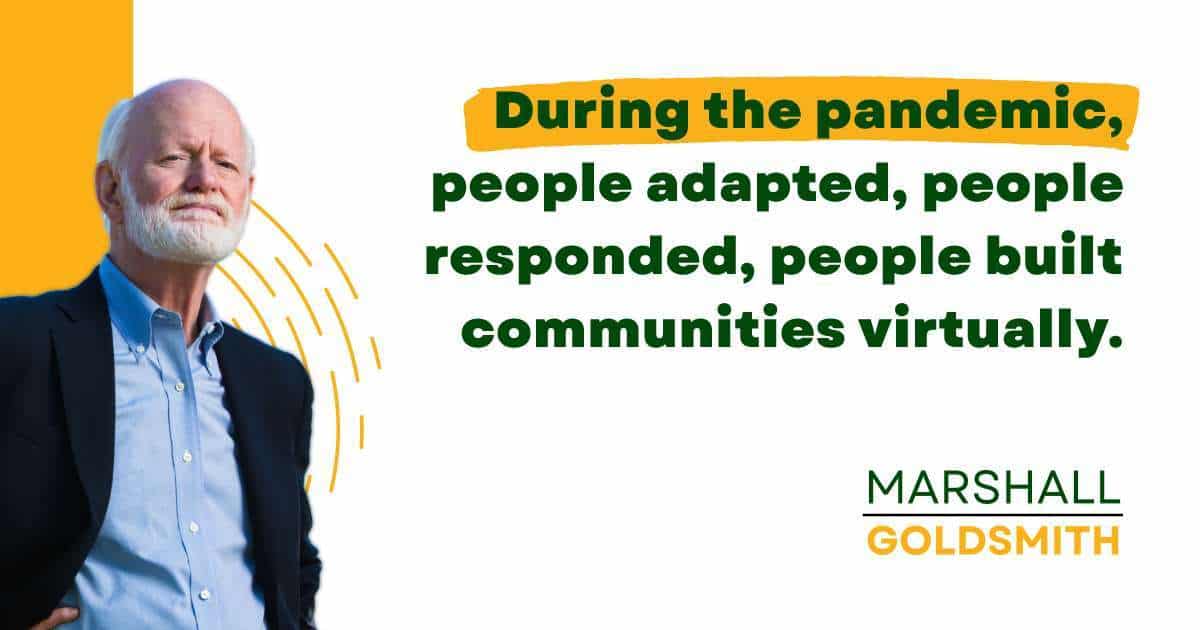Playing Favorites By Marshall Goldsmith There’s a reason I devote...
The Life Plan Review (LPR) survived the pandemic.
When I was starting out the LPR with my 100 Coaches, the Covid pandemic decided to alter the timeline of our in-person meetings.
The LPR is designed to close the gap between what you plan to do in your life and what you actually get done.
There are four steps:
This last is essential — and it turns out that, in a pandemic, you can build an effective and successful virtual community.
I had a sense of responsibility to 100 Coaches and a renewed sense of purpose to protect it during those unprecedented times.
So I made the LPR meetings virtual. And what a success it turned out to be! People adapted, people responded, people built communities virtually.
It all illustrated how much we need each other — and how we can be amazingly successful together.
At the time my wife, Lyda, and I had sold our home in San Diego and moved into an apartment overlooking the Pacific, with the plan to travel to Nashville to look for a home to be near our daughter and grandchildren. The pandemic upended that.
So to cope with the new reality, I opened up a Zoom account, commandeered a corner of the tiny apartment as my “studio,” and announced that I would be hosting a loosely structured seminar every Monday at 10 a.m. EST. Everyone was invited.
I’d open with a 20-minute talk on a single subject, then members would break out into groups of three or four to discuss a question or two I posed to them, before returning to the entire group to report what they learned. The number of people on the call started growing from 35 at the start to more than 100. It was a very diverse international group, from every continent except Antarctica. Many were calling in from middle-of-the-night time zones.
There was value simply in seeing faces and hearing voices from a global community. Eventually, I learned that Zoom has a chat feature and that while I was sermonizing, a lot of people were messaging one another, setting up calls among themselves later on. I thought I was protecting

the community, but the real work was being done by the members at a more granular level. They were saving one another.
By June 2020, it was clear that the pandemic wasn’t fading. With everyone stuck at home, the 100 Coaches community offered the perfect opportunity to beta test the LPR (which we’d introduced to them five months earlier, just before the lockdown) in a group setting.
I conscripted 50 members to commit to answering the six basic LPR questions and reporting their scores on a Zoom call every Saturday or Sunday morning for 10 weeks. I repeated my standard warning about effort-based self-monitoring: “It’s easy to understand. Very hard to stick with.”
When successful people are challenged to grade themselves on effort and then must face their inadequacy in the simple act of trying to achieve a goal they chose, they often give up after two or three weeks. Mostly, though, they feel shame that they failed a test they had written. I expected 10 quitters in our fifty-person group, a 20% dropout rate.
My coaching partner Mark Thompson and I hosted six one-hour back-to-back calls for eight people each weekend that summer. No one skipped out. Members of the group could choose a 9 a.m., 10:30 a.m., or noon slot on either Saturday or Sunday. Some stuck to the same slot, others switched around—which added a nonscientific wrinkle to my informal study. People weren’t accountable to the same group of people each week. People didn’t know who they’d be seeing on the call each week. My job was to ensure that everyone got to meet every other individual at least once.
Ten weeks is long enough to provide some strong indicators of the value of the process.
Everyone charted their weekly scores, so progress or regression was easy to gauge. Over 10 weeks, the members’ effort scores increased steadily. By week 10, people who had started out below 5 for effort were regularly placing themselves in the 8 to 10 range. My takeaway is that if you can get through the early weeks without giving up, some level of success is inevitable. Reviewing the scores each week in public adds accountability, to the group and to yourself. When you see you’re making steady gains, you’re less likely to accept regression to the lower depths again.
This is the primary benefit of the LPR: In a matter of weeks, you’ll notice how brutally it forces you to confront the tough question, “What did I actually do this week to make progress on my goals?” Given our tendencies for superior planning but inferior doing, this is a question we prefer to avoid. The LPR removes that option. This is why participants’ scores start improving so quickly. The alternative—reporting poor scores for trying week after week—is too painful to deal with.

Adding Too Much Value Won’t Get You There By Marshall...
C-Suite Master Class: No, But, However By Marshall Goldsmith Continuing...
The Doerr Institute: Expanding the Market for Coaches By Marshall...
Making Leadership Development Part of the College Degree at Rice...
Sanyin Siang – Winner of the Thinkers50 Marshall Goldsmith Coaching...
Thinkers50 Marshall Goldsmith Distinguished Achievement Award in Coaching – Nominees...
Leading with Influence: What Is Influence360°? By Marshall Goldsmith Founder...
Are You a Dominator, Manipulator, Persuader or Influencer? By Marshall...
Leading with Influence: Redefining Modern Influence Part 2 By Marshall...
My mission is simple. I want to help successful people achieve positive, lasting change and behavior; for themselves, their people, and their teams. I want to help you make your life a little better. With four decades of experience helping top CEOs and executives overcome limiting beliefs and behaviors to achieve greater success, I don’t do this for fame and accolades. I do this because I love helping people!
As an executive educator and coach, I help people understand how our beliefs and the environments we operate in can trigger negative behaviors. Through simple and practical advice, I help people achieve and sustain positive behavioral change.